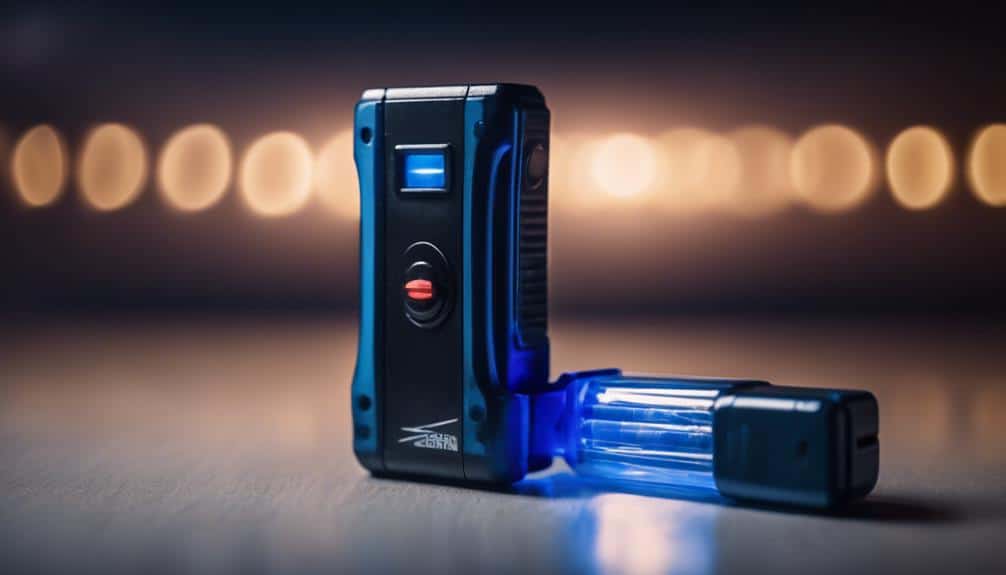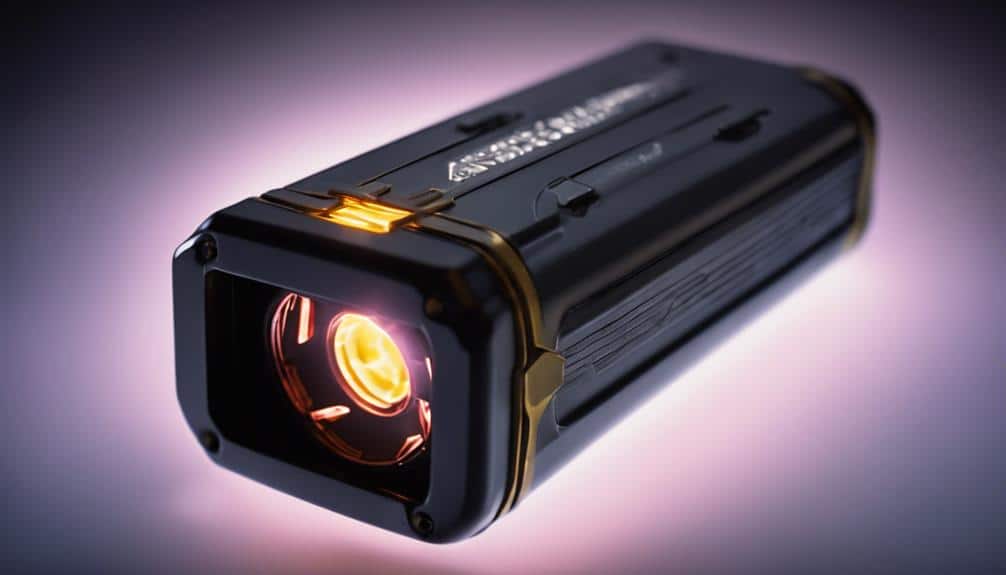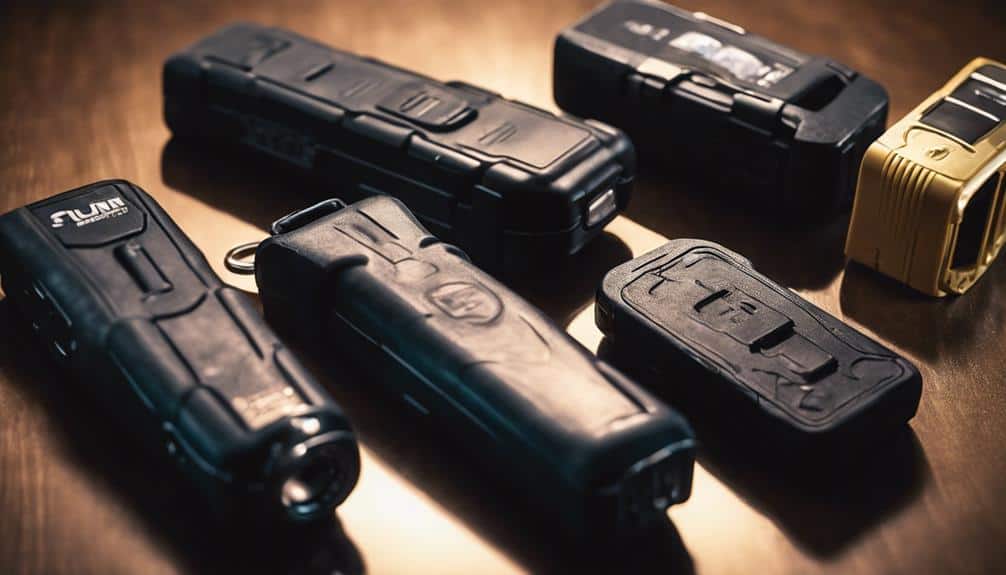What Is a Stun Gun

A stun gun is your trusty, handheld self-defense gadget that zaps would-be attackers with a strong electric shock, giving you peace of mind when you’re alone. It’s small and easy to carry, so you don’t need to be a martial arts master to feel secure. These devices work by disrupting the attacker’s neuromuscular system, causing temporary paralysis—just enough to make a quick getaway. You’ll find different types like pocket stun guns, flashlight stun guns, and even ones disguised as cell phones. Do you want to know how to safely use one and ensure it’s the right fit for you? Keep going!
Definition

A stun gun is a handheld device designed to deliver an electric shock to incapacitate an attacker. Think of it as your personal protection superhero in your pocket. When you’re considering self-defense strategies, a stun gun can be a powerful tool to keep you safe without requiring any martial arts training or superhero skills.
Let’s be honest, we’re not all Bruce Lee. Sometimes, we need an easy and effective way to protect ourselves. That’s where the stun gun steps in. It’s compact, easy to carry, and can be quickly accessed in a pinch. Whether you’re walking to your car late at night or jogging through a quiet park, having a stun gun can provide a sense of security and confidence.
You don’t need to be a tech wizard to use one, either. With a simple button press, you can deliver a high-voltage shock that will give any attacker much more than they bargained for. It’s like having a lightning bolt in your hand but without the Thor costume.
How It Works
When you activate the button on a stun gun, it releases an electrical discharge that can halt an attacker in their tracks. The high voltage shocks the muscles, causing temporary immobilization.
Don’t worry—it’s designed to be a non-lethal means of self-defense. But remember to use it responsibly!
Electrical Discharge Mechanism
Stun guns deliver a high-voltage, low-current electrical shock that disrupts the body’s neuromuscular system. Let’s break this down to understand how it happens.
First, voltage generation is key. Inside a stun gun, a small battery generates an initial low voltage. A transformer steps up this voltage substantially, creating the high voltage necessary for the stun gun to be effective.
Next comes the capacitor discharge. The device stores the generated high voltage in capacitors. Think of capacitors as little energy storage units, waiting for the perfect moment to release their charge. When you press the trigger, these capacitors discharge their stored energy through two electrodes. This is where the magic happens—not magic, but science!
The electrical current travels between the electrodes, creating an intimidating crackling sound and a visible arc of electricity. This isn’t just for show; it’s the real deal. The high-voltage, low-current shock quickly overwhelms the target’s neuromuscular system, causing temporary disorientation and loss of control.
Immobilization Through Voltage
High-voltage shocks from a stun gun disrupt your body’s electrical signals, making it difficult to move. When you get hit with a stun gun, it delivers a jolt of electricity that interferes with your nervous system. Your body’s muscles communicate through electrical impulses, and the stun gun’s electric shock overloads these signals. It’s like trying to listen to your favorite song while someone blasts static on the radio.
Stun guns operate at varying voltage levels, but most are designed to be non-lethal while still being effective. The high voltage (we’re talking thousands or even millions of volts) causes involuntary muscle contractions, making you lose control temporarily. Imagine your muscles doing an awkward dance without your permission—yep, it’s not fun at all!
Don’t worry; the actual current (amperage) is low, so it doesn’t cause long-term harm. It’s the voltage that creates the shocking sensation and immobilizes you. Your body gets confused, and you feel like a robot with a malfunctioning motherboard. So, while the electric shock is definitely unpleasant, it’s designed to incapacitate rather than injure. It’s a zappy way to stop someone in their tracks!
Safety and Usage
Understanding the safety and proper usage of a stun gun is vital to guaranteeing it serves its purpose effectively without causing undue harm. When used correctly, a stun gun can be a valuable tool for self-defense benefits, giving you peace of mind in uncertain situations. However, it’s important to undergo proper user training to handle this device responsibly.
First, never point a stun gun at someone unless you’re in immediate danger. It’s not a toy, and misuse can lead to serious consequences. During your training, you’ll learn how to aim for larger muscle groups, such as the thigh, abdomen, or shoulder, to maximize effectiveness without causing permanent injury. The goal is to incapacitate an attacker, temporarily giving you time to escape.
Always keep your stun gun charged and readily accessible, but also ensure it’s stored safely away from children or unauthorized users. Practice using it in a controlled environment to get comfortable with its weight and trigger mechanism.
And remember, like in any superhero movie, with great power comes great responsibility. The last thing you want is to accidentally zap yourself or a friend during a demonstration gone awry!
Types of Stun Guns

When choosing a stun gun, you’ll find several types designed to suit different needs and preferences. Let’s start with pocket models. These compact stun guns are perfect if you’re looking for something that fits easily into your bag or pocket. They’re small but mighty, packing a punch without taking up much space. Imagine having a powerful defense tool that’s as easy to carry as your smartphone. Handy, right?
Next up, we’ve flashlight stun guns. These are like the Swiss Army knives of stun guns. They combine a flashlight’s functionality with a stun gun’s protective power. So, if you’re walking your dog at night or searching for your keys in the dark, you’ve got a useful light source that doubles as a self-defense tool. Plus, bad guys probably won’t suspect a thing until it’s too late!
There are also baton stun guns, which are longer and provide extra reach, and cell phone guns, which look like everyday devices. Each type offers unique benefits, so consider what best fits your lifestyle. Whatever you choose, remember that the best stun gun is one you’ll feel comfortable using.
Effectiveness
The importance of a stun gun largely depends on its voltage, amperage, and your ability to use it confidently in high-pressure situations. Imagine you’re in a real-world scenario where every second counts.
The stun gun’s voltage determines the punch it packs, while the amperage affects how much it can disrupt an attacker’s nervous system. It’s like comparing a light drizzle to a thunderstorm—both are water, but one makes a bigger splash.
User experience plays a vital role, too. If the stun gun is easy to handle and you’ve practiced using it, you’ll feel more confident when it matters most. Think of it like riding a bike; the more you practice, the better you get.
In real-world scenarios, you need to be quick and precise. A stun gun with a higher voltage might sound impressive, but it won’t be very effective if it’s bulky or confusing to use.
Safety Considerations

Guaranteeing your stun gun’s excellent safety features can make all the difference in a crisis. First, let’s talk about battery maintenance. Keeping your stun gun’s battery charged is like ensuring your phone doesn’t die in the middle of a call. You wouldn’t want your stun gun to run out of juice when you need it most. Regularly check the battery and recharge it as needed. Some models even have indicators to show battery life—use them!
Next up is device storage. Where you keep your stun gun can affect its readiness and longevity. Store it in a cool, dry place, away from kids and pets. A hidden but easily accessible spot in your home or car is ideal. You don’t want to be digging through a closet in an emergency!
Safety switches are another critical feature. Make sure yours has a solid safety switch to prevent accidental discharge. Nothing says ‘Oops!’ like a stun gun going off when you’re just trying to grab your keys.
Legal Issues
Understanding the legal landscape surrounding stun guns is just as important as knowing how to use and maintain them safely. You don’t want to be in hot water just because you don’t know the rules. Both state regulations and federal laws can impact your ability to carry and use a stun gun, and these laws can vary widely depending on where you are.
Federal laws usually lay the groundwork, but state regulations can add more layers. For example, some states require permits, while others might ban stun guns outright. It’s like trying to navigate through a maze, but don’t worry; a little research goes a long way.
Here’s a quick look at how different states handle stun guns:
| State | Permit Required | Banned Areas |
|---|---|---|
| California | Yes | Schools, Gov. Buildings |
| Texas | No | None |
| New York | No | Entire State |
Usage Tips

Now that you know the basics and legal aspects of stun guns, let’s discuss using them wisely.
You’ll need to master proper handling techniques, stay aware of your surroundings, and remember those legal considerations we mentioned.
Ready to become a stun gun pro?
Proper Handling Techniques
When using a stun gun, always grip it firmly to maintain control and guarantee effective deployment. A solid grip ensures you’re ready to act quickly and effectively.
Battery maintenance is important; make sure your stun gun is always charged. You don’t want it to fail you at a critical moment! Regularly check and replace the batteries as needed.
Mastering grip techniques can make a world of difference. Keep your thumb on the safety switch and your index finger on the activation button. This way, you’re prepared to use it in a flash.
Here are some tips to help you handle your stun gun effectively:
- Stay calm: Panic can lead to mistakes. Take a deep breath and focus on your goal.
- Practice makes perfect: Familiarize yourself with your stun gun. Practicing will boost your confidence.
- Use your body’s natural mechanics: Hold the stun gun close to your body, using your arm’s strength for stability.
- Keep it accessible: Stash it somewhere you can easily reach, like a purse or pocket, so you won’t have to fumble around for it when you need it.
Situational Awareness Importance
Using a stun gun to recognize your surroundings and potential threats can greatly enhance your safety. You can’t just walk around in a bubble, oblivious to what’s happening. Personal vigilance is key. Imagine you’re in a movie, and the hero—always alert and ready.
Think of threat detection as your superpower. It’s not about being paranoid; it’s about being prepared. Look around. Who’s nearby? What’s their behavior? Assess quickly but calmly. You don’t need to be Sherlock Holmes; you should be aware enough to spot trouble before it spots you.
Here’s a little table to help you with situational awareness:
| Scenario | Your Action |
|---|---|
| Crowded subway | Keep a hand on your stun gun |
| Dark parking lot | Walk confidently, scan the area |
| Strangers approaching | Stay alert, hand near your stun gun |
| Unfamiliar neighborhood | Keep moving, stay in well-lit areas |
| Loud arguments nearby | Change your route, avoid conflict |
Being aware doesn’t mean you’re living in fear. It means you’re smart and prepared. So, channel your inner action hero, stay vigilant, and keep that stun gun ready. Your safety is in your hands—literally!
Legal Considerations Overview
Understanding the legal considerations of stun gun usage is just as essential as situational awareness for your safety. You might think it’s as simple as buying one and carrying it around, but hold your horses!
Different places have different rules, and you don’t want to end up on the wrong side of the law. Knowing the permit requirements and potential legal ramifications can save you a lot of headaches.
First, check if you need a permit. Some states require one before you can legally carry a stun gun. Ignoring this could result in hefty fines or even jail time.
Second, be aware of where you can carry it. Just because you have a permit doesn’t mean you can bring it everywhere. Schools, government buildings, and airports are usually no-go zones.
To keep things simple:
- Check local laws: Laws vary widely by state and city.
- Permits: Find out if you need one.
- Restricted areas: Know where you can’t carry it.
- Legal ramifications: Understand the consequences of misuse.
Choosing the Right Model
Choosing the appropriate stun gun model involves considering factors like size, power, and ease of use to guarantee it meets your specific needs. First, consider the brand reputation and battery life. A well-known brand often means reliability and quality. You don’t want your stun gun to conk out when you need it most. Look for models with long-lasting batteries so you’re not constantly charging them.
Next, consider size and power. Do you want something compact that fits in your purse or pocket, or are you okay with a larger model? Power is essential, too. Higher voltage means more stopping power, but it can also make the device bulkier.
Ease of use is another key factor. You should feel comfortable and confident operating it. Features like a safety switch or a flashlight can be real game-changers.
Here’s a handy table to help you compare:
| Model | Size | Battery Life |
|---|---|---|
| Compact X1 | Small | Up to 6 hours |
| Defender Pro | Medium | Up to 10 hours |
| Mighty Zap | Large | Up to 12 hours |
| Mini Shock | Extra Small | Up to 4 hours |
| PowerMax | Medium-Large | Up to 8 hours |
